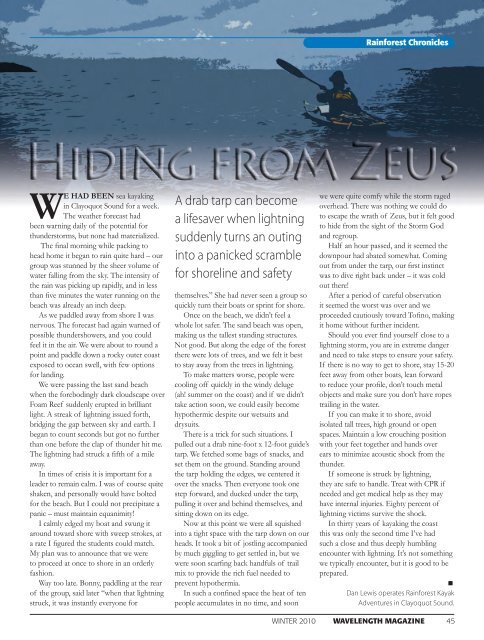Tricked out kayaks Hitting the water - Wavelength Paddling Magazine
Tricked out kayaks Hitting the water - Wavelength Paddling Magazine
Tricked out kayaks Hitting the water - Wavelength Paddling Magazine
Create successful ePaper yourself
Turn your PDF publications into a flip-book with our unique Google optimized e-Paper software.
Rainforest Chronicles<br />
WE HAD BEEN sea kayaking<br />
in Clayoquot Sound for a week.<br />
The wea<strong>the</strong>r forecast had<br />
been warning daily of <strong>the</strong> potential for<br />
thunderstorms, but none had materialized.<br />
The final morning while packing to<br />
head home it began to rain quite hard – our<br />
group was stunned by <strong>the</strong> sheer volume of<br />
<strong>water</strong> falling from <strong>the</strong> sky. The intensity of<br />
<strong>the</strong> rain was picking up rapidly, and in less<br />
than five minutes <strong>the</strong> <strong>water</strong> running on <strong>the</strong><br />
beach was already an inch deep.<br />
As we paddled away from shore I was<br />
nervous. The forecast had again warned of<br />
possible thundershowers, and you could<br />
feel it in <strong>the</strong> air. We were ab<strong>out</strong> to round a<br />
point and paddle down a rocky <strong>out</strong>er coast<br />
exposed to ocean swell, with few options<br />
for landing.<br />
We were passing <strong>the</strong> last sand beach<br />
when <strong>the</strong> forebodingly dark cloudscape over<br />
Foam Reef suddenly erupted in brilliant<br />
light. A streak of lightning issued forth,<br />
bridging <strong>the</strong> gap between sky and earth. I<br />
began to count seconds but got no fur<strong>the</strong>r<br />
than one before <strong>the</strong> clap of thunder hit me.<br />
The lightning had struck a fifth of a mile<br />
away.<br />
In times of crisis it is important for a<br />
leader to remain calm. I was of course quite<br />
shaken, and personally would have bolted<br />
for <strong>the</strong> beach. But I could not precipitate a<br />
panic – must maintain equanimity!<br />
I calmly edged my boat and swung it<br />
around toward shore with sweep strokes, at<br />
a rate I figured <strong>the</strong> students could match.<br />
My plan was to announce that we were<br />
to proceed at once to shore in an orderly<br />
fashion.<br />
Way too late. Bonny, paddling at <strong>the</strong> rear<br />
of <strong>the</strong> group, said later “when that lightning<br />
struck, it was instantly everyone for<br />
A drab tarp can become<br />
a lifesaver when lightning<br />
suddenly turns an <strong>out</strong>ing<br />
into a panicked scramble<br />
for shoreline and safety<br />
<strong>the</strong>mselves.” She had never seen a group so<br />
quickly turn <strong>the</strong>ir boats or sprint for shore.<br />
Once on <strong>the</strong> beach, we didn’t feel a<br />
whole lot safer. The sand beach was open,<br />
making us <strong>the</strong> tallest standing structures.<br />
Not good. But along <strong>the</strong> edge of <strong>the</strong> forest<br />
<strong>the</strong>re were lots of trees, and we felt it best<br />
to stay away from <strong>the</strong> trees in lightning.<br />
To make matters worse, people were<br />
cooling off quickly in <strong>the</strong> windy deluge<br />
(ah! summer on <strong>the</strong> coast) and if we didn’t<br />
take action soon, we could easily become<br />
hypo<strong>the</strong>rmic despite our wetsuits and<br />
drysuits.<br />
There is a trick for such situations. I<br />
pulled <strong>out</strong> a drab nine-foot x 12-foot guide’s<br />
tarp. We fetched some bags of snacks, and<br />
set <strong>the</strong>m on <strong>the</strong> ground. Standing around<br />
<strong>the</strong> tarp holding <strong>the</strong> edges, we centered it<br />
over <strong>the</strong> snacks. Then everyone took one<br />
step forward, and ducked under <strong>the</strong> tarp,<br />
pulling it over and behind <strong>the</strong>mselves, and<br />
sitting down on its edge.<br />
Now at this point we were all squished<br />
into a tight space with <strong>the</strong> tarp down on our<br />
heads. It took a bit of jostling accompanied<br />
by much giggling to get settled in, but we<br />
were soon scarfing back handfuls of trail<br />
mix to provide <strong>the</strong> rich fuel needed to<br />
prevent hypo<strong>the</strong>rmia.<br />
In such a confined space <strong>the</strong> heat of ten<br />
people accumulates in no time, and soon<br />
we were quite comfy while <strong>the</strong> storm raged<br />
overhead. There was nothing we could do<br />
to escape <strong>the</strong> wrath of Zeus, but it felt good<br />
to hide from <strong>the</strong> sight of <strong>the</strong> Storm God<br />
and regroup.<br />
Half an hour passed, and it seemed <strong>the</strong><br />
downpour had abated somewhat. Coming<br />
<strong>out</strong> from under <strong>the</strong> tarp, our first instinct<br />
was to dive right back under – it was cold<br />
<strong>out</strong> <strong>the</strong>re!<br />
After a period of careful observation<br />
it seemed <strong>the</strong> worst was over and we<br />
proceeded cautiously toward Tofino, making<br />
it home with<strong>out</strong> fur<strong>the</strong>r incident.<br />
Should you ever find yourself close to a<br />
lightning storm, you are in extreme danger<br />
and need to take steps to ensure your safety.<br />
If <strong>the</strong>re is no way to get to shore, stay 15-20<br />
feet away from o<strong>the</strong>r boats, lean forward<br />
to reduce your profile, don’t touch metal<br />
objects and make sure you don’t have ropes<br />
trailing in <strong>the</strong> <strong>water</strong>.<br />
If you can make it to shore, avoid<br />
isolated tall trees, high ground or open<br />
spaces. Maintain a low crouching position<br />
with your feet toge<strong>the</strong>r and hands over<br />
ears to minimize acoustic shock from <strong>the</strong><br />
thunder.<br />
If someone is struck by lightning,<br />
<strong>the</strong>y are safe to handle. Treat with CPR if<br />
needed and get medical help as <strong>the</strong>y may<br />
have internal injuries. Eighty percent of<br />
lightning victims survive <strong>the</strong> shock.<br />
In thirty years of kayaking <strong>the</strong> coast<br />
this was only <strong>the</strong> second time I’ve had<br />
such a close and thus deeply humbling<br />
encounter with lightning. It’s not something<br />
we typically encounter, but it is good to be<br />
prepared.<br />
<<br />
Dan Lewis operates Rainforest Kayak<br />
Adventures in Clayoquot Sound.<br />
WINTER 2010 WAVELENGTH MAGAZINE 45

















